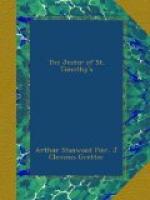It sailed clear over the heads of the intervening players; Newell had been signaled to, had got down the field and was ready for it; three St. Timothy’s players ran to get under the ball, but instead of blocking Newell off and merely trying to spoil his catch, they all tried to make the catch themselves; they all leaped for it. Newell was the quickest; he grabbed the ball out of the air and went down instantly, with the three others on him—but he was on St. Timothy’s ten-yard line.
It was a brilliant pass and a brilliant catch; St. Timothy’s stood looking on disconsolate, while the Harvard players gathered exultantly for the line-up. Three rushes through tackle and centre and one run round Lawrence’s end carried the ball across St. Timothy’s line for a touchdown. Ballard kicked the goal.
There was no more scoring that half. In the second half St. Timothy’s kicked off; Harvard got the ball and set about rushing it back up the field. They had gained ten yards and had carried the ball forty yards from their own goal, when they lost possession of it on a fumble. The spectators cheered, and began shouting,—
“Touchdown, St. Timothy’s, touchdown!”
There was more shouting when, with Collingwood interfering
for him,
Dennison broke through the Harvard left tackle and
made fifteen yards.
Then Collingwood made a quarter-back kick which Morrill
captured on the
Harvard five-yard line.
The St. Timothy’s cheering broke out afresh, Scarborough leading it. Irving joined in the cheer; he was glad to see Collingwood and the others making gains—provided they did not make them round Lawrence’s end.
On the five-yard line the Harvard defense stiffened. On the third down the ball was two yards from the goal line.
“Everybody get into this next play—everybody!” cried Collingwood appealingly; he went about slapping his men on the back. “Now then—twelve, thirty-seven, eighteen.”
There was a surge forward, a quivering, toppling mass that finally fell indecisively. No one knew whether the ball had been pushed across or not. No one wanted to get up for fear it might be pushed one way or the other in the shifting.
Barclay and Randolph, who was umpire, began summarily dragging the players from the pile, hauling at an arm or a leg; at last Dennison was revealed at the bottom hugging the ball—and it was just across the line.
Then all the St. Timothy’s players capered about for joy, and the spectators shouted as triumphantly as if it had been the St. John’s game; the Harvard team ranged themselves quietly under the goal. Dennison kicked the goal, and the score was tied.
For the next ten minutes neither team succeeded in making much progress. St. Timothy’s were playing more aggressively than in the first half; twice Kenyon, the Harvard halfback, started to skirt round Lawrence’s end, but both times Baldersnaith, the St. Timothy’s tackle, broke through and dragged him down. Baldersnaith, Dennison, Morrill, and Collingwood were especially distinguishing themselves for the School.




